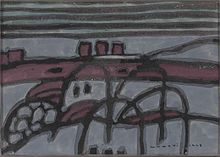Kim Whanki
Kim Whanki ( Korean 김환기 ; born February 27, 1913 on Anjwado Island in Sinan-gun County, Jeollanam-do Province , Korea ; † July 25, 1974 in New York City ) was a South Korean painter of abstract art.
Spelling of his name
Different transliterations of his name were used in western countries . In addition to the transliterations used in this article, others such as Kim Whan-Ki and Kim Hwan-gi are known. The names Suhwa and Soohwa also exist as surnames.
Live and act
Kim Whanki was born on February 27, 1913 in the village of Eupdong-ri ( 읍동리 ) on Anjwado Island ( 안좌도 ) in Sinan-gun County ( 신안군 ) in Jeollanam-do ( 전라남도 ) Province . Nothing is known about his childhood. At the age of 18 he attended Nishikishiro High School in Tokyo and enrolled as a student in the Faculty of Fine Arts at Nihon University in Tokyo in 1933 , where he graduated three years later. He had his first solo exhibition in Tokyo.
In 1937 he returned to Korea and lived in Seoul , where he founded the group Sinsasil-pa ( 신사 실파 ), a group of the school of new realism, in 1943 together with some painters who had also studied painting in Japan . His influential status in the art scene led him to receive a professorship at the Faculty of Fine Arts at Seoul National University ( 서울 대학교 ), where he taught from 1946 to 1949. During the Korean War , he went to Busan, and then after the war ended in 1954, he accepted a teaching position at Hongik University ( 홍익 대학교 ) in Seoul.
In 1956 Kim went to Paris and had his solo exhibitions there, as well as in Nice and Brussels . In Paris he was able to study the contemporary masters, which helped him to become aware of his own art and to preserve his typical Korean poetry in his painting.
In 1959 he went back to Seoul, continued to work as a professor at Hongik University and became director of the Korean Art Association . In 1963 he took part in the Biennale in São Paulo , to which he was invited as a representative of South Korea and was awarded an honorary prize there. He then moved to New York , escaping the pressures of Korean social obligations, exposing himself and his art to the opportunities that the metropolis offered and reinventing himself. In the early 1970s, he then dealt with surfaces, points and lines in order to create compositions.
In his private life, Kim, who was interested in the traditional culture and ancient art of his home country, collected antiques, old paintings and calligraphy.
Kim Whanki, who had a companion during his creative time in Kim Hyangan ( 김향안 ) (1916-2004), died on July 25, 1974 in New York. After his death, Kim Hyang-an established the Whanki Foundation in South Korea and later the Whanki Museum in Seoul.
Working as an artist
The director of the Whanki Museum in Seoul, Park Mee-jung ( 박미정 ), divided Kim's work as an artist in an article in the magazine Koreana from 2015 into two periods, first the period of his teenage years when he, quote:
“... looked for the roots of his creative work and devoted himself to questions of the method of representation, the time of the Sinsasil activities, when he was faithful to his ideals of representation, the Parisian years (1956–1959), when he developed his identity as an artist and explored the essence of art ... "
including Kim's participation in the Biennale in Sao Paulo in 1963.
She sees the beginning of his second creative period in his move to New York , the city in which he also died. Park sees his work here shaped by various experiments with form and the “internalization of a contemplative and objective perception and exploration of nature”.
literature
- Park Mee-jung: Kim Whanki . Landscape of transcendence and the aesthetics of the sublime. In: Koreana . Volume 10, No. 1. The Korea Foundation , 2015, ISSN 1975-0617 , p. 8–11 (German-language edition).
Web links
- 현재 전시 . Whanki Museum,accessed November 22, 2017(Korean, exhibition notes).
- 김환기 . Naver,accessed November 22, 2017(Korean).
- Kim Whan-ki . Christie's,accessed November 22, 2017.
Individual evidence
- ↑ Kim, Hwan-gi . Virtual International Authority File , accessed November 22, 2017 .
- ↑ Kim, Whan-Ki . German National Library, accessed on November 22, 2017 .
- ↑ Min Kyungso: Kim, Whanki [ 김환기 ] (1913–1974). Routledge , accessed November 22, 2017 .
- ↑ a b c Park: Kim Whanki . In: Koreana . 2015, p. 9 .
- ↑ a b Park: Kim Whanki . In: Koreana . 2015, p. 10 .
- ↑ a b Park: Kim Whanki . In: Koreana . 2015, p. 11 .
- ↑ Park: Kim Whanki . In: Koreana . 2015, p. 8 .
| personal data | |
|---|---|
| SURNAME | Kim, Whanki |
| ALTERNATIVE NAMES | Kim, Whan-Ki; Kim, Hwan-gi |
| BRIEF DESCRIPTION | South Korean painter |
| DATE OF BIRTH | February 27, 1913 |
| PLACE OF BIRTH | Anjwado Island , Sinan-gun County, Jeollanam-do Province , Korea |
| DATE OF DEATH | July 25, 1974 |
| Place of death | new York |

